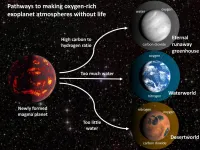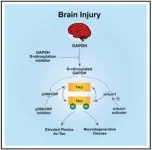(Press-News.org) Researchers have identified molecular signatures of the aging process in mice, publishing their results today in the open-access eLife journal.
Their analyses provide one of the most comprehensive characterisations of the molecular signatures of aging across diverse types of cells from different tissues in a mammal, and will aid future studies on aging and related topics.
Aging leads to the decline of major organs and is the main risk factor for many diseases, including cancer, cardiovascular and neurodegenerative diseases. While previous studies have highlighted different hallmarks of the aging process, the underlying molecular and cellular mechanisms remain unclear.
To gain a better understanding of these mechanisms, the Tabula Muris Consortium created the single-cell transcriptomic dataset, called Tabula Muris Senis (TMS). The TMS contains over 300,000 annotated cells from 23 tissues and organs of male and female mice. "These cells were collected from mice of diverse ages, making the data a tremendous opportunity to study the genetic basis of aging across different tissues and cell types," says first author Martin Jinye Zhang, Postdoctoral Researcher in the Department of Epidemiology, Harvard University, Boston, US.
The original TMS study* mainly explored the cell-centric effects of aging, aiming to characterise changes in the composition of cell types within different tissues. In the current gene-centric study, Zhang and colleagues focused on changes in gene expression that occur during the aging process across different cell types.
Using the TMS data, they identified aging-dependent genes in 76 cell types from 23 tissues. They then characterised the aging behaviours of these genes that were both shared among all cell types ('globally') and specific to different tissue cells.
"We found that the cell-centric and gene-centric perspectives of the previous and current studies are complementary, as gene expression can change within the same cell type during aging, even if the composition of cells in the tissue does not vary over time," explains co-senior author Angela Oliveira Pisco, Associate Director of Bioinformatics at the Chan Zuckerberg Biohub, San Francisco, US. "The identification of many shared aging genes suggests that there is a coordinated global aging behaviour in mice."
The team then used this coordinated activity to develop a single-cell aging score based on the global aging genes. This new high-resolution aging score revealed that different tissue-cell types in the same animal can have a different aging status, shedding light on the diverse aging process across different types of cells.
"Taken together, our results provide a characterisation of aging genes across a wide range of tissue-cell types in the mouse," concludes senior author James Zou, Assistant Professor of Biomedical Data Science at Stanford University, Stanford, US, and a Chan Zuckerberg Biohub Investigator. "In addition to providing new biological insights on the aging process, this work serves as a comprehensive reference for researchers working in related fields."
INFORMATION:
This study will be published as part of 'Aging, Geroscience and Longevity: A Special Issue' from eLife. To view the Special Issue, visit https://elifesciences.org/collections/6d673315/aging-geroscience-and-longevity-a-special-issue.
For more information about the Chan Zuckerberg Biohub, visit https://www.czbiohub.org.
*The Tabula Muris Consortium., Almanzar, N., Antony, J. et al. A single-cell transcriptomic atlas characterizes ageing tissues in the mouse. Nature 583, 590-595 (2020). https://doi.org/10.1038/s41586-020-2496-1
Media contact
Emily Packer, Media Relations Manager
eLife
e.packer@elifesciences.org
+44 (0)1223 855373
About eLife
eLife is a non-profit organisation created by funders and led by researchers. Our mission is to accelerate discovery by operating a platform for research communication that encourages and recognises the most responsible behaviours. We aim to publish work of the highest standards and importance in all areas of biology and medicine, including Computational and Systems Biology, while exploring creative new ways to improve how research is assessed and published. eLife receives financial support and strategic guidance from the Howard Hughes Medical Institute, the Knut and Alice Wallenberg Foundation, the Max Planck Society and Wellcome. Learn more at https://elifesciences.org/about.
To read the latest Computational and Systems Biology research published in eLife, visit https://elifesciences.org/subjects/computational-systems-biology.
In the search for life on other planets, the presence of oxygen in a planet's atmosphere is one potential sign of biological activity that might be detected by future telescopes. A new study, however, describes several scenarios in which a lifeless rocky planet around a sun-like star could evolve to have oxygen in its atmosphere.
The new findings, published April 13 in AGU Advances, highlight the need for next-generation telescopes that are capable of characterizing planetary environments and searching for multiple lines of evidence for life in addition to detecting oxygen.
"This ...
After interviewing various stakeholders from public and private healthcare systems (in Lithuania and the US), researchers Dr Agne Gadeikiene, Prof Asta Pundziene, Dr Aiste Dovaliene from Kaunas University of Technology (KTU), Lithuania designed a detailed structure revealing added value of remote healthcare services, i.e. telehealth. Adopting the concept of value co-creation common in business research to healthcare, the scientists claim that this is the first comprehensive analysis of this kind in the healthcare field involving two different healthcare systems.
According to the researchers, although in the US the consultations via phone with physician have been available for more than fifty ...
A gene therapy protects eye cells in mice with a rare disorder that causes vision loss, especially when used in combination with other gene therapies, shows a study published today in eLife.
The findings suggest that this therapy, whether used alone or in combination with other gene therapies that boost eye health, may offer a new approach to preserving vision in people with retinitis pigmentosa or other conditions that cause vision loss.
Retinitis pigmentosa is a slowly progressive disease, which begins with the loss of night vision due to ...
Violent blows or jolts to the head can cause traumatic brain injury (TBI), and there are currently about five million people in the U.S. living with some form of chronic impairment after suffering a TBI. Even in a mild form, TBI can lead to lifelong nerve cell deterioration associated with a wide array of neuropsychiatric conditions. Tragically, there are no medicines to protect nerve cells after injury. Behind aging and genetics, TBI is the third leading cause of Alzheimer's disease (AD), yet the link between these two conditions is not understood.
In a new study, published online today in Cell, researchers have discovered a new way to prevent brain nerve cells from deteriorating after injury, which also revealed a potential mechanistic ...
AMES, Iowa - Narratives are a powerful tool that can help explain complex issues, but they can also serve as sources of misinformation, which presents a challenge as public health agencies work to educate people about COVID-19 vaccine.
In a paper published by the Proceedings of the National Academy of Sciences, author Michael Dahlstrom, a professor and director of Iowa State University's Greenlee School of Journalism and Mass Communication, examined how narratives or storytelling can help counter misinformation and provide a connection between science and the human experience. Dahlstrom says simply presenting the facts, without some connection, may not help people make ...
Bottom Line: The U.S. Preventive Services Task Force (USPSTF) concludes that the current evidence is insufficient to make a recommendation about screening for vitamin D deficiency in asymptomatic adults. Vitamin D performs an important role in bone metabolism. Requirements may vary by individual and no one blood vitamin D level defines deficiency. The USPSTF routinely makes recommendations about the effectiveness of preventive care services and this recommendation updates and is consistent with its 2014 statement.
To access the embargoed study: Visit our For The Media website at this link https://media.jamanetwork.com/
(doi:10.1001/jama.2021.3069)
Editor's Note: Please see the article for additional ...
New research led by the Garvan Institute of Medical Research has revealed how breast cancer cells that develop during or after pregnancy change their environment to form more aggressive tumours.
In experimental models of pregnancy-associated breast cancer, researchers found that cancer cells send signals to the connective tissue around them to trigger uncontrolled inflammation and remodel the tissue, which in turn helps the cancer to spread.
"Breast cancers that arise during or shortly after pregnancy are highly aggressive as they often become resistant to standard therapies. With 50% of cases ...
Huntington's disease is a genetic neurodegenerative disorder caused by mutations in the protein huntingtin and characterized by involuntary dance-like movements, severe behavioural changes and cognitive impairment. That neuronal traffic is impaired in this disease has been very well known for several years. But that this deranged trafficking could be ameliorated by increasing huntingtin methylation was not yet known. The findings emerged from an international research work coordinated by the University of Trento and published in Cell Reports.
The research teams identified the fundamental role of the protein arginine methyltransferase PRMT6 in ensuring transport along axons, the routes that connect nerve cells to each other, and hence the health of neurons. ...
Researchers from the group of Hans Clevers (Hubrecht Institute) developed the first patient-derived organoid model for cervical cancer. They also modelled the healthy human cervix using organoids. In close collaboration with the UMC Utrecht, Princess Máxima Center for pediatric oncology and the Netherlands Cancer Institute, the researchers used the organoid-based platform to study sexually transmitted infections for a herpes virus. The model can potentially also be used to study the human papillomavirus (HPV), which is one of the main causes of cervical cancer. The results were published in Cell Stem Cell on the 13th of April.
Cervical cancer is a common gynecological malignancy, often caused by the human papillomavirus (HPV). However, good models to study human ...
(Boston)--How could studying gastrointestinal cells help the fight against COVD-19, which is a respiratory disease? According to a team led by Gustavo Mostoslavsky, MD, PhD, at the BU/BMC Center for Regenerative Medicine (CReM) and Elke Mühlberger, PhD, from the National Emerging Infectious Diseases Laboratories (NEIDL) at Boston University, testing how SARS-CoV-2 affects the gut can potentially serve to test novel therapeutics for COVID-19.
In order to study SARS-CoV-2, models are needed that can duplicate disease development in humans, identify potential targets and enable drug testing. BU researchers have created human induced pluripotent stem cells (iPSC)-derived intestinal organoids or 3-D models that can be infected and replicated ...




